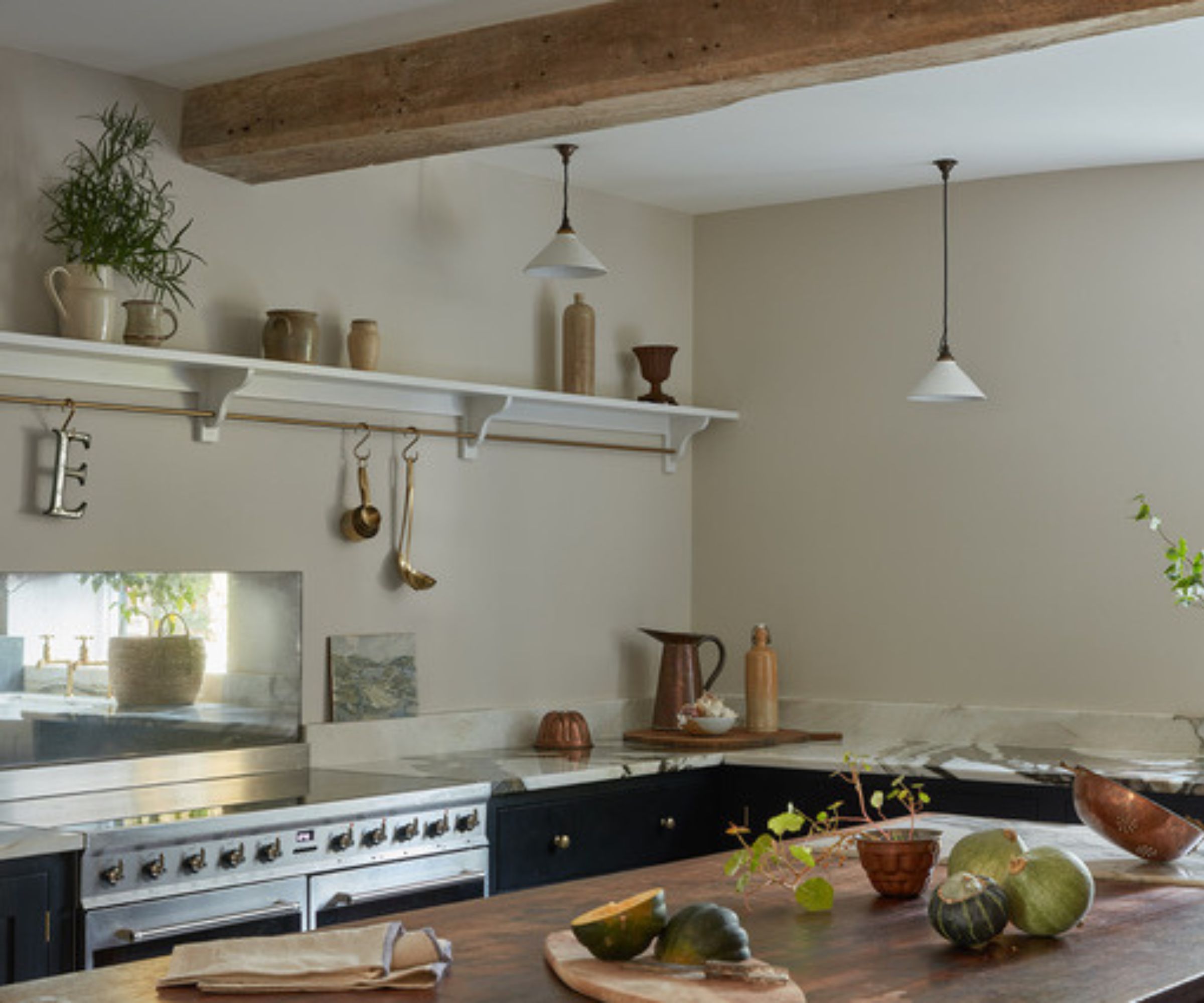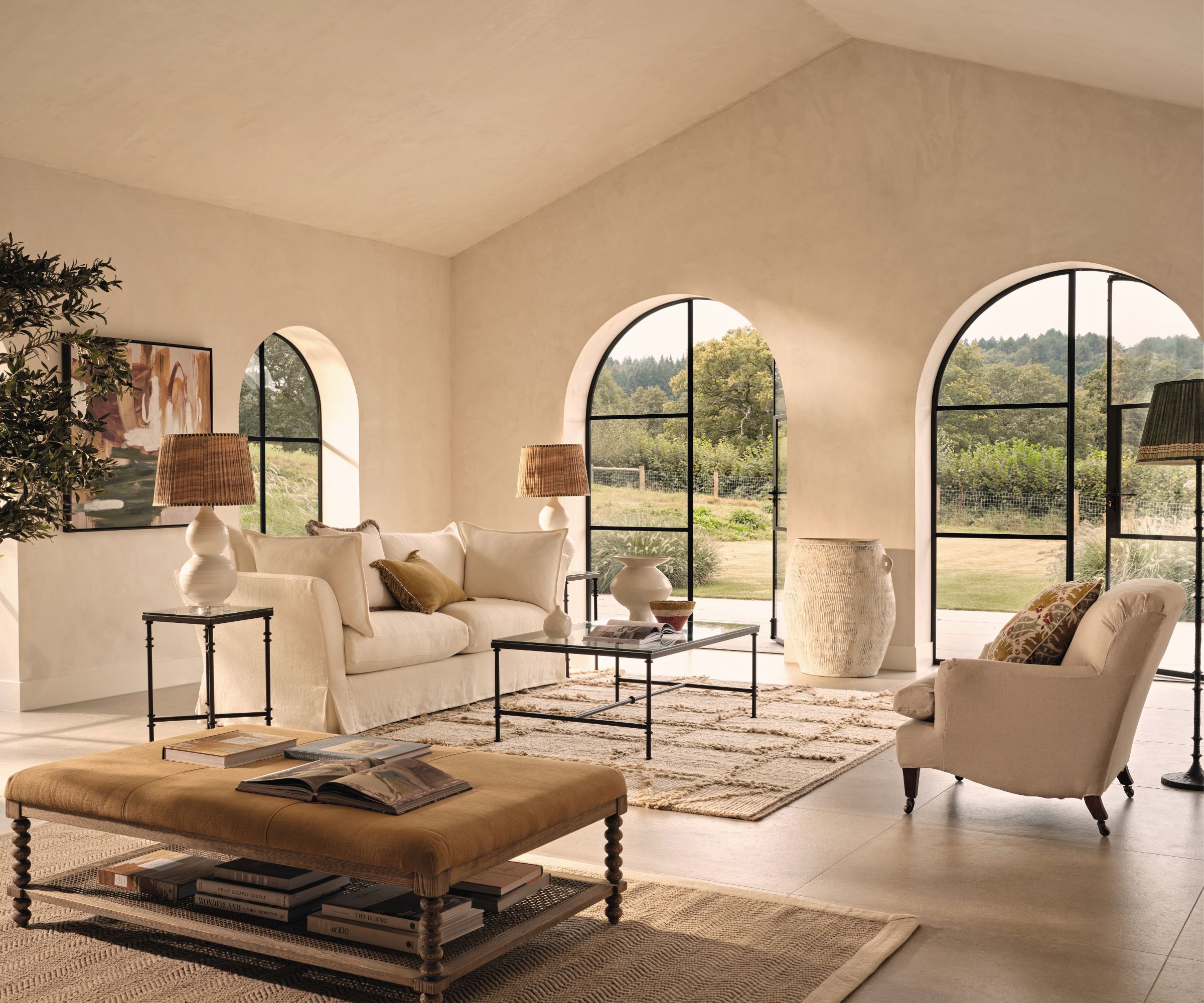What is modern Mediterranean interior design? Designers explore this chic yet rustic European aesthetic
This grounding interior design style pairs warm neutrals with relaxing Mediterranean hues and rustic materials


We're all familiar with traditional Mediterranean-style homes. Terracotta roof tiles, vibrant hues of reds, yellows and blues, and wall tiles decorated with bright, swirling designs all come to mind. And while these spaces will always endure, not everyone has a taste for the busy style they're renowned for.
Cue modern Mediterranean interior design – the traditional style's more relaxed, subtle cousin. While this variation still celebrates the design details that are core to Mediterranean decor, the modernized version offers a more subtle, minimal approach that feels more attainable to less vibrant tastes.
So, what is modern Mediterranean interior design, and how can you introduce it into your home? We've turned to interior designers to discover what defines modern Mediterranean design, and how they choose to decorate in this interior design style.
What is modern Mediterranean interior design?

You've probably seen the vivacious decor of classic Mediterranean style, with riotous colors and patterned tiles, but modern Mediterranean interior design is a more paired-back version that exudes elegance. It captures the historic, characterful style with the addition of more modern elements.
'It's all about seamlessly juxtaposing the comforts of modern living with the rich, and historic old-world elements of the Mediterranean world,' says Ivonne Ronderos, principal at DKOR Interiors. 'In essence, modern Mediterranean to us is the subtle combination of contemporary and updated touches while retaining the essence, warmth, and character of Mediterranean architecture and influence,' she adds.

Where traditional Mediterranean design is full of more vibrant hues and busy patterns, this modern approach is more subtle and simple in style. 'Modern Mediterranean style cultivates an atmosphere of casual elegance as the overdone stuffy details seen in typical Mediterranean style have been replaced with more simplistic and easy-going elements,' says Aimee Marling, design director and VP at Monarch & Maker.
The key is to create a space that is homely and characterful – nothing is too pristine or overly curated. Ali Davin, of Jute Interior Design, describes Modern Mediterranean interiors as 'a warm, inviting, home that is of a cozy scale. Nothing is too precious. And it looks better with age and wear.'
Design expertise in your inbox – from inspiring decorating ideas and beautiful celebrity homes to practical gardening advice and shopping round-ups.
Ivonne Ronderos agrees, adding that this design style creates 'a timeless feel of a home that has history and has existed throughout time. It evokes a sense of stability and history while also offering freshness (timeless yet youthful) and warmth throughout.'
What are the key design elements of modern Mediterranean interior design?

Modern Mediterranean interior design still embraces the key elements of the traditional style, but with a more simplistic, sophisticated approach. 'Modern Mediterranean design is a curated blend of handcrafted and simple elements, offering a refreshing update to the classic style that was so popular in the early to mid-2000s,' explains Aimee Marling.
Warm wood finishes, earthy tones, exposed beams, and arches are all still core to modern Mediterranean interior design, helping to introduce timeless appeal. 'The traditional natural features such as stucco exteriors, terra-cotta roofs, wood beam details, plaster walls, and ironwork are still front and center,' she adds.
'However, the color palettes are lighter and many of the lines are cleaner which opens a window of opportunity for an eclectic mix of furnishings, giving the space a touch of modernity to balance the timeless charm. It’s all about honoring the historical Mediterranean details while embracing the now,'
How to decorate with modern Mediterranean interior design
1. Use neutral colors with Mediterranean hues

The base of any modern Mediterranean scheme is a neutral color on the walls – 'usually a warm white as a base with warm neutrals layered in,' says Ali Davin. Opt for shades that feel light and airy, but still add warmth and a nod to the Mediterranean color palette.
'White still seems to be the dominant color for modern Mediterranean interiors, presumably owing to the generosity of natural light. But freshen this idea by using nuanced whites with a specific color tone lying underneath- from the gentle pink kiss of Tailor Tack through to the blue-based cleanness of Borrowed Light with its soft cool notes,' says Patrick O’Donnell, brand ambassador at Farrow & Ball.

Once you've decided on your white-toned base, you can begin to introduce subtle hues of Mediterranean colors. 'Complement with other hues like warm browns (with less red undertone than we might have seen years ago), muted pastels, and earthy greens,' suggests Ivonne Ronderos.
You can get really creative when it comes to adding color – modern Mediterranean style leans into eclectic, lived in homes, so adding a more daring design detail can really work well. 'Have fun on your ceiling with broad hand-painted stripes in a spiced red like Bamboozle. Or for something more discreet, the aqua tones of Dix Blue will add interest while still offering a calming visual experience,' Patrick O’Donnell recommends.
2. Opt for simple furniture with a few accent pieces

The idea of simplicity comes to fruition with the furniture pieces in a modern Mediterranean home. 'You’ll find simple, clean silhouetted pieces are prominent in this style of interior design, which plays a huge part in creating the desired calm atmosphere, reflective of the Mediterranean coast. Furniture often takes a pared-back form; think metal-framed coffee tables and sideboards, and structured sofas,' explains Sue Jones, co-founder and creative director at OKA.
Despite this, you can still add points of interest – as long as not every piece of furniture is unique and statement, you can introduce a few striking items, such as an antique side table or patterned ottoman. 'When it comes to furniture, a more contemporary Mediterranean home will choose certain accent pieces to evoke the Mediterranean vibe,' explains Ivonne Ronderos. 'Not everything needs to be a showstopper – you can allow those unique pieces to really stand out.'
3. Add interest with decor

The decorative items can really bring this design style to life. Much inspiration for modern Mediterranean design is taken from the outside, so try to infuse as much of this into your scheme as you can. 'A faux olive tree really does the trick for an instant injection of the Mediterranean style; for a real statement, go for an extra-large one paired with a terracotta planter,' says Sue Jones.
Textures and organic shapes are key (wooden textures and arched details are core to modern Mediterranean design), so consider this when choosing decor items. 'Decorative pieces tend to take a more curvaceous shape, such as voluminous table lamps, vases, and planters in terracotta, with a white finish or stoneware,' she suggest.
Soft furnishings are integral for creating a sense of coziness, and they're a great way to introduce those more saturated colors into a space. 'It’s important to think about the earthy tones as well; these are easy to bring in and even better if you can incorporate them with linen textures – try earthy yellow cushion covers or a rusty orange rug to add a pop of color,' Sue Jones adds.
4. Introduce decorative tiles

Tiles are an integral part of Mediterranean design, and they still feel essential in more modern interpretations. Instead of the brightly colored, busy patterned designs you'd find in more traditional spaces, opt for my subtle patterns.
Designer Ivonne Ronderos suggests opting for 'wider-format general flooring with subtle Mediterranean inlays. In bathroom designs, add decorative tiles laid out in an interesting pattern alongside rich materials and simple, modern integrated sinks.'
The floor is an ideal place to add these more interesting details – paired with the more neutral, relaxed bones of the space, it can add a striking detail without feeling overwhelming.
5. Create flow between your interiors and outside space

No modern Mediterranean home would be complete with an easy flow between inside and outdoors. Allow as much natural light to filter into your space as possible – make the most of large windows and, where possible, opt for large patio doors that can be left open during the warmer seasons.
'Indoor/outdoor flow is key to a successful Mediterranean home.' explains Ali Davin. 'Welcoming gardens, cozy courtyards, and outdoor living spaces adjacent to the home are key. As are French doors in as many rooms as possible.'
Modern Mediterranean interior design is a lighter, more relaxed version of its traditional predecessor. Where vibrant tones would dominate, the modern rendition opts for paler, more subtle hues. The main takeaway is the core design elements remain the same, and infusing the essence of Mediterranean living is key. Keep things simple and allow an easy flow between your interiors and garden space – this interior design style should feel easy, not forced.

I’ve worked in the interiors magazine industry for the past five years and joined Homes & Gardens at the beginning of 2024 as the Kitchens & Bathrooms editor. While I love every part of interior design, kitchens and bathrooms are some of the most exciting to design, conceptualize, and write about. There are so many trends, materials, colors, and playful decor elements to explore and experiment with.


